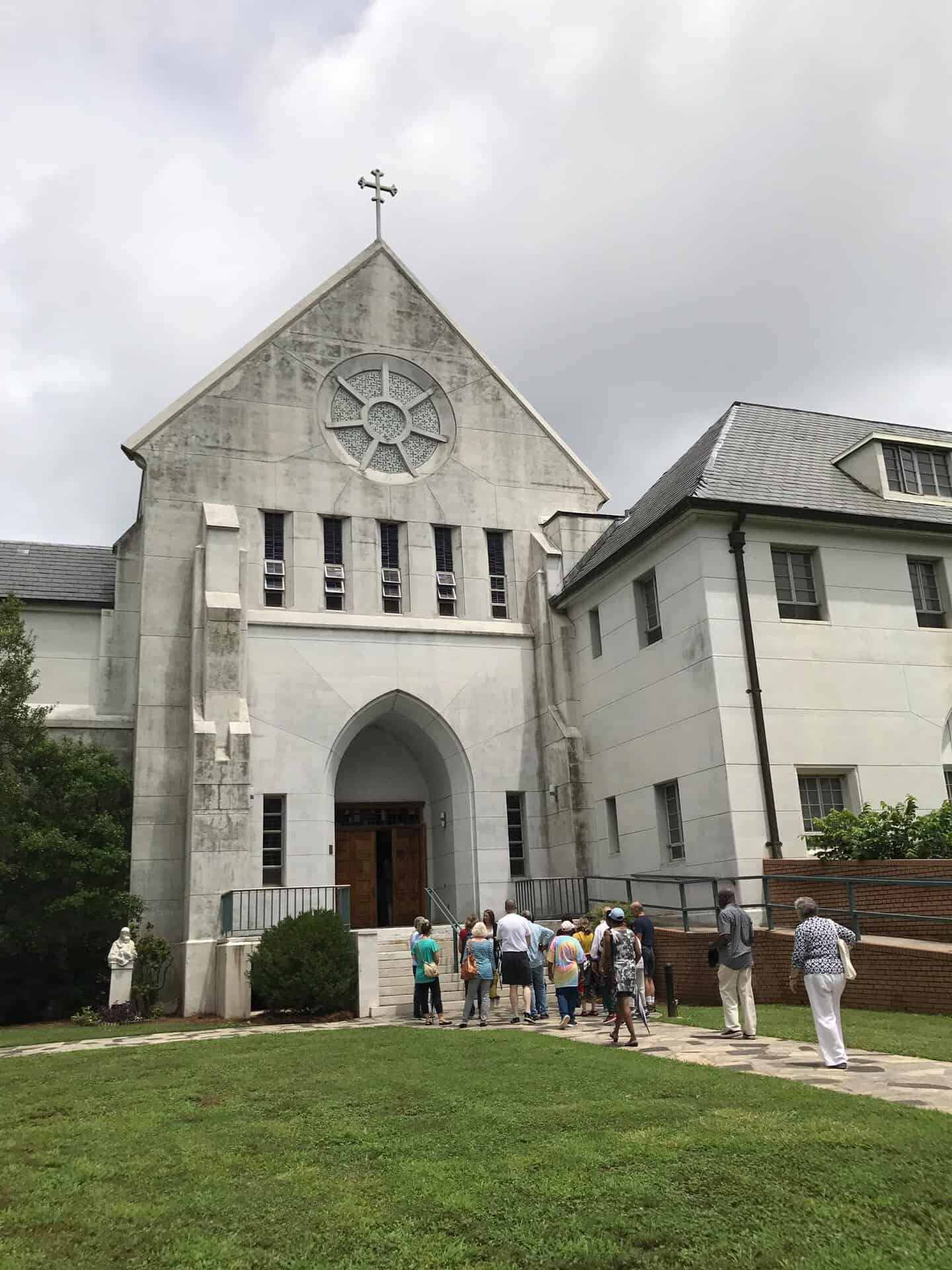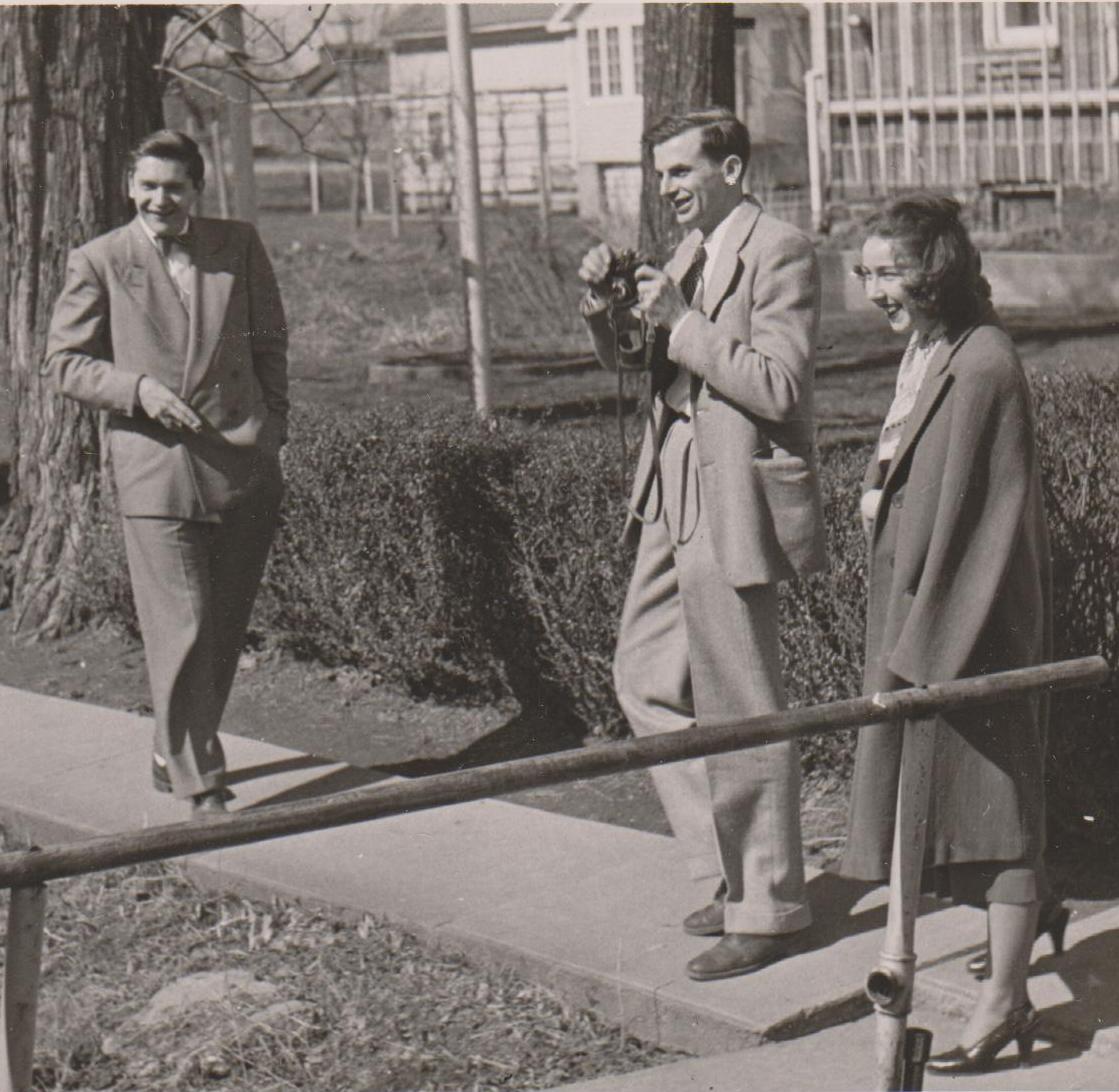Flannery O’Connor’s Connection To The Monastery Of The Holy Spirit
On the Georgia author’s 100th birthday, we look at how Flannery O’Connor discovered the Monastery, and how some of her famous peacocks wound up there.
March 25th this year marks the centennial birthday of one of Georgia’s most famous and iconic authors: Flannery O’Connor. Renowned for her short fiction, especially the collection A Good Man Is Hard To Find, and her dark Southern Gothic style, O’Connor wrote 2 novels and more than 30 short stories—in addition to winning three O. Henry awards and attending the prestigious Iowa Writers’ Workshop—all before passing away from lupus at the age of just 39.
In addition to being a devoted writer, O’Connor was also a devout Catholic and had a strong connection to the Monastery of the Holy Spirit in Conyers. The iconic monastery is not far (about 65 miles) from O’Connor’s home, called Andalusia Farm, in Milledgeville, where the author produced the bulk of her creative output.

The concrete facade of the distinct, brutalist-style Abbey Church at the Monastery of the Holy Spirit.
Friends With Monks
“She had a long-lasting relationship with a preacher here in her suffering and dying years,” said Father Methodius, the stained glass artist for the Monastery who also helped build the church.
That preacher was Father Paul Bourne, who corresponded and visited with O’Connor regularly from 1959 until the author’s passing in ’64. More than two decades after O’Connor’s death, Fr. Bourne reflected on this relationship in Volume 17 (1988) of The Flannery O’Connor Bulletin in a piece entitled “My Friendship with Flannery O’Connor.” The Cistercian Monk wrote:
My personal encounters with Flannery O’Connor were very limited because of the restrictions of my life as a Trappist monk. But I can say that it was nevertheless intense in the sense that we “hit it off” from the beginning. Flannery seemed to find comfort in writing to me of both her problems and her successes. And on those treasured occasions when we did get together, I would say we both felt as though we were simply continuing an interrupted dialogue.
I think of Flannery as one of the few unique persons I have ever encountered. I say unique in the sense of possessing important qualities found in no one else. This uniqueness is of course displayed in her one-of-a-kind literary productions. To search in other authors for models or parallels for the majority of her short stories is useless. I believe her critics are close to unanimous in this judgment. To me this is an author’s mark of genius, which is quite apart from the gift of talent.
But Flannery was at the same time an entirely human person, influenced by human prejudices. I recall her indignation when the old style painted plaster statues of the Virgin and saints were discarded from the local parish church, an updating gesture. But they had been given to the church by the Cline and O’Connor families!
Flannery’s humanity rounded out her rich personality, which found interest in a gamut of subjects and persons. Flannery was unique but, at the same time, universal.
I close with these few generalizations, which offer my best-remembered impressions of this impressive person.
O’Connor first visited the monastery in 1959 and instantly took a liking to Fr. Bourne. In a letter to her friend Betty Hester, dated May 30 of that same year, O’Connor wrote: “Yesterday we did finally get to the [Holy Ghost] monastery taken there by Tom Gossett—and spent the afternoon with Billy’s friend, Fr. Paul. Billy is very fortunate to have such a person for a spiritual adviser. Strangely enough, Billy rather resembles him, in looks and otherwise. Fr. Paul appears to have all Billy’s virtues and none of his failings—a kind of Billy with the dross burnt out. My mother enjoyed him hugely as he is a gardener. She came back with various kinds of ivey [sic]. I hope to give them some peacocks for the place when they get ready for them.”
After that, O’Connor and her mother became regulars at the Holy Spirit for Sunday Mass and even sometimes lunch with the monks. O’Connor also enjoyed retreats at the Monastery’s Retreat House. According to Brad Gooch’s biography Flannery: A Life of Flannery O’Connor, the writer had a number of friendships with Holy Spirit monks, including the influential Dom Augustine Moore, abbot at the Monastery for 26 years (1957-83). On page 350, Gooch writes: “[O’Connor and her mother] would then linger to visit with the monks, especially the abbot, Augustine More [sic], and the bonsai expert and gardener Father Paul Bourne, also chief censor for the Trappist order in America and, so, [Thomas] Merton’s bête noire.”

The Monastery’s sanctuary, where O’Connor and her mother would’ve attended Sunday Mass.
Living With Lupus
Diagnosed with lupus at 25, the same disease that claimed her father’s life when O’Connor was just 16, the Georgia native frequently wrote about faith, mortality and impermanence. Abbot Moore and Fr. Bourne soon became fixtures in O’Connor’s life, and even had a hand in one of her literary endeavors. The two monks facilitated talks between O’Connor and Dominican nuns from the Lady of Perpetual Help Free Cancer Home in Atlanta. The nuns wanted O’Connor to fictionalize the life of a girl named Mary Ann who died of a face tumor at age 12 at their Cancer Home. Although O’Connor encouraged the nuns to write it themselves as nonfiction, the Milledgeville author agreed to edit the manuscript and write an introduction. In a letter to her editor Robert Giroux from 1960, O’Connor wrote: “Fr. Paul thinks it’s quite comic that they have lit on me to do this. He asked them which of my murder stories gave them the idea I should help them with it.”
This slim volume did get published as A Memoir of Mary Ann. And O’Connor penned an eloquent essay as an introduction. Although she doesn’t mention lupus in this piece, O’Connor was no doubt thinking of her own affliction, when she wrote:
The creative action of the Christian’s life is to prepare his death in Christ. It is a continuous action in which this world’s goods are utilized to the fullest, both positive gifts and what Père Teilhard de Chardin calls ‘passive diminishments.’ Mary Ann’s diminishment was extreme, but she was equipped by natural intelligence and by a suitable education, not simply to endure it, but to build upon it. She was an extraordinarily rich little girl.
O’Connor had a morbid intuition that her life would be shortened by lupus. This knowledge, coupled with the author’s deep Catholic faith and fixation on the grotesqueries and flawed characters of the Deep South, formed O’Connor’s uniquely quirky and Southern Gothic style. Only her fictive world, so richly absurd and distinctly Southern, could’ve contained such characters as Hazel Motes from Wise Blood, who preaches the “Church of Christ Without Christ” in front of a movie house; or Manley Pointer from “Good Country People,” a traveling Bible salesman who seduces a woman in a hayloft to steal away with her wooden leg. O’Connor’s oeuvre brims with the beautiful absurdities of existence and, in particular, Southern living.

Flannery O’Connor (far right) at Amana Colonies in Iowa in October 1947, shortly after graduating from the Iowa Writers’ Workshop.
Faith And Fowl
It wasn’t just religion that connected O’Connor to the Monastery of the Holy Spirit and its monks. The Southern writer also had a love of peacocks, at one point owning up to 40 of the squawking fowl at Andalusia Farm. Abbot Moore was also a bit of a birder. In a letter to her writer friend Cecil Dawkins from July 1962, O’Connor wrote: “My total of new peafowls for the year is eight, and the Abbot at the Trappist Monastery gave me three Muscovy ducks, so the general balance is kept.”
In the spring of 1964, in failing health and near the end of her life, O’Connor gifted six of her peacocks to the Conyers Monastery. The exotic birds were kept in a long, fenced-off section by Monastery Lake just north of the Abbey Church. The peafowl, however, quickly overstayed their welcome.
“People came to visit them,” recalled Father Methodius, who was at the Holy Spirit at the time. “They’re pretty animals, but noisy as hell.”
Monks at the Monastery belong to the Order of Cistercians of the Strict Observance (OCSO) and take vows to maintain peaceful, cloistered and contemplative lives. The constant wailing and crowing of the peacocks, and their aggressive behavior, began to fray a few nerves. After just a few months, the monks voted to re-home the half-dozen beautiful birds. To this day, the remains of their old enclosure can still be seen by the lake.

The old peacock enclosure not far from the Retreat House and Abbey Church.
O’Connor’s Monastery Legacy
As for O’Connor’s correspondence with Fr. Bourne, sadly, nothing remains of that. “Along with Thomas Merton, Flannery has been an often requested topic for our archives,” said Monastery archivist Brother Chaminade. “Unfortunately, we have nothing of either. Rumor has it that a former monk took all files with him. Nothing can be substantiated of that rumor other than to say we have nothing of Flannery. But she was, indeed, often in contact with our Father Paul Bourne.”
While those letters are lost, O’Connor does mention Fr. Bourne and Abbot Moore frequently in her collected correspondence. In fact, Abbot Moore was a visitor during the last months of the renowned Southern writer’s life. In a letter to her friend Louise Abbott, dated May 28 1964, just two months before her passing, O’Connor wrote: “This evening I had a visit from the Abbot, bubbling over as usual. Regina (she’s up here staying with my aunt) met him on his way in & told him he could stay 3 minutes (I got the high blood). He was here a full 30 I am sure.”
____________________________________________________________________
To learn more about the Monastery of the Holy Spirit’s fascinating history, join a guided tour on the 2nd Saturday of each month or take part in a free, self-guided tour starting at the Monastic Heritage Center. Visit our Eventbrite for more information.